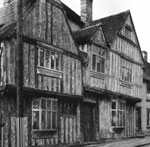
A house of historical and architectural interest
The last house in Lavenham to be owned by the Earls of Oxford
De Vere House, which has also been known as the de Vere Hunting Lodge, Oxford House and Oxford Cottages, was one of three properties within the centre of Lavenham, which were owned by the de Vere family and attached to Lavenham Hall. The house continued uninterrupted in de Vere ownership from the 14th to 17th centuries. It is a grade 1 listed property because of its architectural and historical interest.
Originally a 14th century hall house, de Vere House was extended in the period immediately following the Battle of Bosworth (1485), and then later partially demolished and rebuilt in 1929. Very little of the 14th century hall remains, but the 15th century extension (in particular most of the internal and external beams and some of the internal and external brickwork) is pretty much as it was over 500 years ago.
The house contains a number of interesting features, including: a stone spiral staircase based on that in Oxburgh Hall; the remains of one of the last garderobes to be installed in this country; a rare and original medieval wall painting; and a magnificent front door-way, with its carved huntsmen (dating back to the early 15th century) and the heraldic symbols of John de Vere, the 13th earl of Oxford (boar, star, wool jack and scales).
Both the exterior and interior of the house are a splendid commemoration to the de Vere family, who were centre stage at most of the important historical events of the 11th to 17th centuries.
Below is the on line link to the history of De Vere House (and the De Vere family’s other properties in Essex and Suffolk) from the book Vero Nihil Verius. The following extract includes diagrams and photographs (many never seen before) and may be of interest to anyone wanting to find out more about the house, its history and its architecture.
https://docs.google.com/document/d/1TlXLyaOf21Ilio3lf1Bi6M8bamhQxUppNOsNYaSGk4U/edit?usp=sharing
